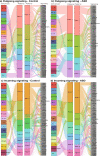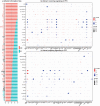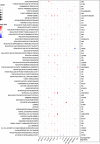Characterization of cell-cell communication in autistic brains with single-cell transcriptomes
- PMID: 35501678
- PMCID: PMC9059394
- DOI: 10.1186/s11689-022-09441-1
Characterization of cell-cell communication in autistic brains with single-cell transcriptomes
Abstract
Background: Autism spectrum disorder is a neurodevelopmental disorder, affecting 1-2% of children. Studies have revealed genetic and cellular abnormalities in the brains of affected individuals, leading to both regional and distal cell communication deficits.
Methods: Recent application of single-cell technologies, especially single-cell transcriptomics, has significantly expanded our understanding of brain cell heterogeneity and further demonstrated that multiple cell types and brain layers or regions are perturbed in autism. The underlying high-dimensional single-cell data provides opportunities for multilevel computational analysis that collectively can better deconvolute the molecular and cellular events altered in autism. Here, we apply advanced computation and pattern recognition approaches on single-cell RNA-seq data to infer and compare inter-cell-type signaling communications in autism brains and controls.
Results: Our results indicate that at a global level, there are cell-cell communication differences in autism in comparison with controls, largely involving neurons as both signaling senders and receivers, but glia also contribute to the communication disruption. Although the magnitude of changes is moderate, we find that excitatory and inhibitor neurons are involved in multiple intercellular signaling that exhibits increased strengths in autism, such as NRXN and CNTN signaling. Not all genes in the intercellular signaling pathways show differential expression, but genes in the affected pathways are enriched for axon guidance, synapse organization, neuron migration, and other critical cellular functions. Furthermore, those genes are highly connected to and enriched for genes previously associated with autism risks.
Conclusions: Overall, our proof-of-principle computational study using single-cell data uncovers key intercellular signaling pathways that are potentially disrupted in the autism brains, suggesting that more studies examining cross-cell type effects can be valuable for understanding autism pathogenesis.
Keywords: Autism; Brain; Cell-cell communication; Ligand-receptor; Network; Single-cell RNA-seq.
© 2022. The Author(s).
Conflict of interest statement
The authors declare that they have no competing interests.
Figures








Similar articles
-
Cellular stress and apoptosis contribute to the pathogenesis of autism spectrum disorder.Autism Res. 2018 Jul;11(7):1076-1090. doi: 10.1002/aur.1966. Epub 2018 May 15. Autism Res. 2018. PMID: 29761862 Free PMC article.
-
The genetics of autism.Pediatrics. 2004 May;113(5):e472-86. doi: 10.1542/peds.113.5.e472. Pediatrics. 2004. PMID: 15121991 Review.
-
Cellular and molecular characterization of multiplex autism in human induced pluripotent stem cell-derived neurons.Mol Autism. 2019 Dec 30;10:51. doi: 10.1186/s13229-019-0306-0. eCollection 2019. Mol Autism. 2019. PMID: 31893020 Free PMC article.
-
Single-cell brain organoid screening identifies developmental defects in autism.Nature. 2023 Sep;621(7978):373-380. doi: 10.1038/s41586-023-06473-y. Epub 2023 Sep 13. Nature. 2023. PMID: 37704762 Free PMC article.
-
[Role of NRXN-NLGN-SHANK pathway gene variations in the pathogenesis of autism spectrum disorders].Zhonghua Yi Xue Yi Chuan Xue Za Zhi. 2018 Oct 10;35(5):753-756. doi: 10.3760/cma.j.issn.1003-9406.2018.05.031. Zhonghua Yi Xue Yi Chuan Xue Za Zhi. 2018. PMID: 30298512 Review. Chinese.
Cited by
-
Systematic Bibliometric and Visualized Analysis of Research Hotspots and Trends on Autism Spectrum Disorder Neuroimaging.Dis Markers. 2022 Jul 18;2022:3372217. doi: 10.1155/2022/3372217. eCollection 2022. Dis Markers. 2022. PMID: 35899177 Free PMC article.
-
Context-aware deconvolution of cell-cell communication with Tensor-cell2cell.Nat Commun. 2022 Jun 27;13(1):3665. doi: 10.1038/s41467-022-31369-2. Nat Commun. 2022. PMID: 35760817 Free PMC article.
-
Identifying condition-related cell-cell communication events using supervised tensor analysis.bioRxiv [Preprint]. 2025 Jun 19:2023.12.15.571918. doi: 10.1101/2023.12.15.571918. bioRxiv. 2025. PMID: 38168391 Free PMC article. Preprint.
-
Single-Nucleus Transcriptomics of the Nucleus Accumbens Reveals Cell-Type-Specific Dysregulation in Adolescent Macaques with Depressive-Like Behaviors.Neurosci Bull. 2025 Jul;41(7):1127-1144. doi: 10.1007/s12264-025-01412-5. Epub 2025 May 21. Neurosci Bull. 2025. PMID: 40399551
-
Molecular and network disruptions in neurodevelopment uncovered by single cell transcriptomics analysis of CHD8 heterozygous cerebral organoids.Heliyon. 2024 Jul 18;10(14):e34862. doi: 10.1016/j.heliyon.2024.e34862. eCollection 2024 Jul 30. Heliyon. 2024. PMID: 39149047 Free PMC article.
References
-
- American Psychiatric Association . Highlights of changes from DSM-IV-TR to DSM-5. 2013.
-
- Maenner MJ, Shaw KA, Baio J, Washington A, Patrick M, DiRienzo M, et al. Prevalence of autism spectrum disorder among children aged 8 years-autism and developmental disabilities monitoring network, 11 sites, United States, 2016. MMWR Surveill Summ. 2020;69:1–12. doi: 10.15585/mmwr.ss6904a1. - DOI - PMC - PubMed

